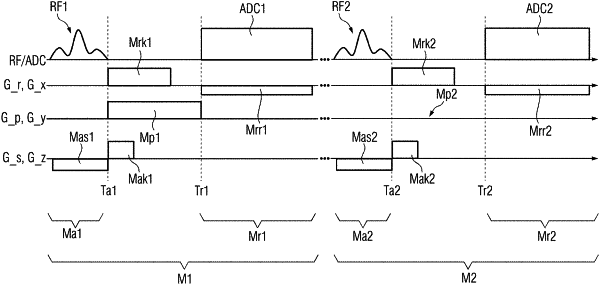| CPC G01R 33/543 (2013.01) [A61B 5/055 (2013.01); G01R 33/5615 (2013.01)] | 14 Claims |

|
1. A method for optimizing an MR control sequence embodied to acquire magnetic resonance (MR) data of an examination subject by means of a magnetic resonance device comprising gradient coils, the method comprising:
providing an MR control sequence comprising at least two sequence portions, each having an excitation portion, a phase encoding portion and a readout portion, wherein the phase encoding portion is in each case arranged between the excitation portion and the readout portion with respect to time;
providing at least one defined parameter for the MR control sequence;
providing an optimization objective;
ascertaining a usage time of the gradient coils between the excitation portion and the readout portion with respect to time for each of the at least two sequence portions;
optimizing the excitation portions for each of the at least two sequence portions taking into account the ascertained usage time for the corresponding sequence portion and the at least one defined parameter with regard to the optimization objective; and
providing the optimized MR control sequence comprising the optimized excitation portions,
wherein the duration of the optimized excitation portion for a first sequence portion of the at least two sequence portions, which is embodied for acquiring MR data in a raw data space closer to the center of the raw data space, is longer than the duration of the optimized excitation portion for a second sequence portion of the at least two sequence portions, which is embodied for acquiring MR data further away from the center of the raw data space.
|